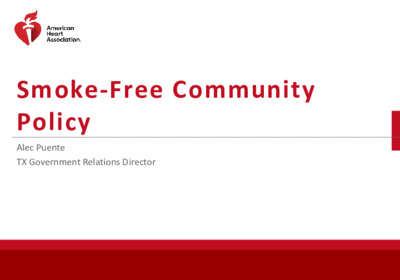Austin ESD presentation — original pdf
Backup

Smoke-Free Community Policy Alec Puente TX Government Relations Director Why is Clean Air Important? Review of the Research around Smoke-Free Air • US Surgeon General: Secondhand smoke linked to disease and premature death and those who do not smoke. • Children at higher risk for SIDS, acute respiratory problems, ear infections, asthma attacks, and slowed lung growth • Adults suffer cardiovascular effects, coronary heart disease, and lung cancer • No risk-free level of exposure, regardless of ventilation systems • No adverse impact on hospitality industry • Centers for Disease Control: risk of myocardial infarction and heart disease increases rapidly at relatively small doses, such as those from secondhand smoke • Secondhand smoke is particularly hazardous to elderly people, individuals with cardiovascular disease, and individuals with impaired respiratory function, including asthmatics and those with obstructive airway disease. 2 Business Impacts • Data, surveys, and qualitative research all indicate that smoke-free policies are popular and do not have an adverse effect on economic activity. • The North America Hotel Guest Satisfaction Index Study (issued by J.D. Power and Associates) found that, “Nearly nine of 10 guests (89%) say they prefer a smokefree hotel environment in 2008.” • World Health Organization: “smoke-free policies often have a positive economic impact.” • Data shows no effect on bar or restaurant employment. • University of Florida: no negative effect on hotel, restaurant, or tourism revenue or employment; small positive effect on restaurant revenue. • Smoke-free policies have positive effects on profitability, productivity, maintenance costs, and insurance rates. 3 Electronic Smoking Devices & Secondhand Aerosol E-cigarettes, vaporizers, an other new products • ESDs heat and vaporize a solution typically containing nicotine. These are now the most commonly-used form of tobacco by youth in the US. • Not emission-free; the aerosol contains volatile organic compounds, ultrafine particles, heavy metals, and flavorings linked to lung disease and cancer. • May exacerbate respiratory ailments like asthma, or constrict arteries leading to a heart attack. of nicotine. environments. • Non-smokers exposed to cigarette smoke and ESD aerosols absorb similar levels • ESDs have gained competitive advantages in part because of loopholes and gaps in regulation that have allowed them to be used in typically-smoke free • Exposure is declining, but more than 20% of nonsmoking adults are still exposed to secondhand smoke. 4 Policy Solutions Comprehensive Smoke-Free Air Ordinances • National best practice states that an ordinance should apply to smoking or e-cigarette use in all workplaces, bars, and restaurants. • Comprehensive ordinances provide the best level of protection not only for patrons and the public, but also workers who often see much higher levels of exposure in non-smoke-free environments. • Common loopholes and exemptions: cigar bars; • • hotel/motel rooms; • private clubs • Should treat ESDs the same way as conventional cigarettes. • Addresses health risks, productivity impacts, and support for individuals attempting to quit. 5 Austin and Statewide Context • Austin passed a comprehensive ordinance in 2005, and amended it in 2017 to include electronic smoking devices. Enforcement is complaint-based. • To date, over 100 Texas cities have passed comprehensive ordinances, with more than 90 applying to both cigarette smoke and ESD aerosols. • Ex: Austin, San Antonio, Houston, El Paso, Ft. Worth, Waco • Recent uptick in local interest around tighter zoning rules to limit number of locations prevent retailers from locating near certain areas, like schools. • State legislature has passed new requirements in recent years to create a permitting structure for e-cigarette retailers and strengthening penalties for repeated sales to minors. • E-cigarettes are still not subject to the tobacco excise tax. 6 “Our business went up!” says Joe Ables, owner of the Saxon Pub for 30 years. “We have more people coming back to see us…smokers got used to going outside. We put a patio out there, made it real nice, and created a whole new scene. Our maintenance costs are lower, too; we don’t have to clear the ashes off the floor, and the AC works a lot better. I have a healthier staff. I highly recommend it.” “Employees, musicians, fans — everyone benefited from a healthier environment and a lot of people who had avoided smoking venues now felt comfortable attending shows there. For those of us playing on stage and singing, not having to take big breaths full of smoke meant we could sing longer and sing better, and that meant a better show for everyone. Looking back, it’s hard to even imagine how anxious I was about the change, and I am so glad those days of indoor smoke in Austin are behind us!” – BettySoo, local artist 7 Thank you! Alec.Puente@heart.org